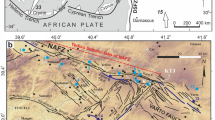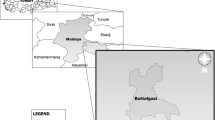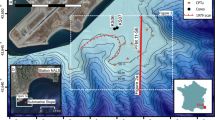Abstract
The magnitudes of prehistoric earthquakes that created liquefaction features (i.e., sandblows) in the South Carolina Coastal Plain (SCCP) are not exactly known. In this study, in situ geotechnical data, including cone penetration test (CPT) data with pore water pressure measurements, in the vicinity of discovered sandblows at Hollywood, Sampit, Gapway, and Fort Dorchester sites located in the SCCP were used with the cyclic stress method and Ground Motion Prediction Equations (GMPEs) to back-calculate the minimum earthquake magnitude (M) and peak ground acceleration (amax) to form a regional assessment of minimum amax-M in the Charleston area. Results indicate that the minimum earthquake magnitude of the prehistoric earthquakes associated with the Charleston Source ranges from 6.6 to 7.2 for the earthquake that occurred about 546 ± 17 years before present (B.P.) and from 6.2 to 6.7 for the earthquake that occurred about 5038 ± 166 years B.P. Results also show that the minimum earthquake magnitude for the prehistoric earthquakes with a source inferred to the Sawmill Branch fault and occurred at least 3500 years ago, ranges from 5.1 to 5.7.












Similar content being viewed by others
References
Aboye SA, Andrus RD, Ravichandran N, Bhuiyan AH, Harman N (2015) Seismic site factors and design response spectra based on conditions in Charleston, South Carolina. Earthquake Spectra 31(2):723–744
Atkinson G (2008) Ground-motion prediction equations for eastern North America from a referenced empirical approach: implications for epistemic uncertainty. Bull Seismol Soc Am 98:1304–1318
Atkinson GM, Boore DM (2011) Modifications to existing ground-motion prediction equations in light of new data. Bull Seismol Soc Am 101(3):1121–1135
Dura-Gomez I, Talwani P (2009) Finding faults in the Charleston area, South Carolina: 1, seismological data. Seismol Res Lett 80(5):883–900
Gheibi E (2016) Improved assessment of the magnitude and acceleration of prehistoric earthquakes in the South Carolina Coastal Plain. Doctoral Dissertation, University of South Carolina, Columbia, SC. Order No. 10240428, University of South Carolina
Gheibi E, Gassman SL (2014) Reassessment of prehistoric earthquake accelerations at Sampit and Gapway sites in the South Carolina Coastal Plain. Proc. 10th US National Conference on Earthquake Engrg (10NCEE), AK. https://doi.org/10.4231/D3PV6B73Z
Gheibi E, Gassman SL (2015) Magnitudes of prehistoric earthquakes at the Hollywood, South Carolina, site. IFCEE 2015:1246–1256. https://doi.org/10.1061/9780784479087.112
Gheibi E, Gassman SL (2016) Application of GMPEs to estimate the minimum magnitude and peak ground acceleration of prehistoric earthquakes at Hollywood, SC. Eng Geol 214:60–66. https://doi.org/10.1016/j.enggeo.2016.09.016
Gheibi E, Gassman SL, Hasek MJ, Talwani P (2017) Assessment of paleoseismic shaking that caused a sand blow at Fort Dorchester, SC. Bull Earthq Eng 15:5119. https://doi.org/10.1007/s10518-017-0180-0
Green RA, Obermeier SF, Olson SM (2005) Engineering geology and geotechnical analysis of paleoseismic shaking using liquefaction effects: field examples. Eng Geol 76:263–293
Hasek MJ (2016) Liquefaction potential as related to the aging of SC outer coastal plain sands. Doctoral Dissertation, University of South Carolina, Columbia, SC
Hayati H, Andrus RD (2009) Updated liquefaction resistance correction factors for aged sands. J Geotech Geoenviron 135(11):1683–1692. https://doi.org/10.1061/ASCEGT.1943-5606.0000118
Hayati H, Andrus RD, Gassman SL, Hasek MJ, Camp WM, Talwani P (2008) Characterizing the liquefaction resistance of aged soils. GEESD IV, Sacramento
Hu K, Gassman SL, Talwani P (2002a) In-situ properties of soils at paleoliquefaction sites in the South Carolina Coastal Plain. Seismol Res Lett 73(6):964–978
Hu K, Gassman SL, Talwani P (2002b) Magnitudes of prehistoric earthquakes in the South Carolina Coastal Plain from geotechnical data. Seismol Res Lett 73(6):979–991
Idriss IM, Boulanger RW (2008) Soil liquefaction during earthquakes. Monograph MNO 12. Earthquake Engineering Research Institute Oakland, California
Ishihara, K (1985) Stability of natural soil deposits during earthquakes, Proc. 11th Conference on Soil Mechanics and Foundation Engineering, San Francisco CA: 321-376
Kulhawy FH, Mayne PW (1990) Manual on estimating soil properties for foundation design. Final Report, Electric Power Research Institute-EL-6800 Palo Alto, CA, 1493-6
Leon E, Gassman SL, Talwani P (2005) Effect of soil aging on assessing magnitudes and accelerations of prehistoric earthquakes. Earthquake Spectra 21(3):737–759
Leon E, Gassman SL, Talwani P (2006) Accounting for soil age when assessing liquefaction potential. J Geotech Geoenviron 132(3):363–377
Martin JR (1990) Implications from a geotechnical investigation of liquefaction phenomeno associated with seismic events in the Charleston, SC area. Doctoral Dissertation, Virginia Polytechnic Institute and State University
Martin JR, Clough GM (1994) Seismic parameters from liquefaction evidence. J Geotech Eng ASCE 120(8):1345–1361
McCartan L, Lemon EM, Weems RE (1984) Geologic map of the area between Charleston and Orangeburg, South Carolina. United States Geological Survey Miscellaneous Investigations Map I-1472
Mesri G, Feng TW, Banek JM (1990) Postdensification penetration resistance of clean sands. J Geotech Eng-ASCE 116(7):1095–1115
Obermeier SF, Weems RE, Jacobson RB (1987) Earthquake-induced liquefaction features in the coastal South Carolina region. US Geological Survey (USGS) Open-File Report, 87, 504
Olson SM, Green RA, Obermeier SF (2005) Geotechnical analysis of paleoseismic shaking using liquefaction features: a Major Updating. Eng Geol 76(3):235–261
Petersen MD, Moschetti MP, Powers PM, Mueller CS, Haller KM, Frankel AD, Zeng Y, Rezaeian S, Harmsen SC, Boyd OS et al. (2014) Documentation for the 2014 update of the United States national seismic hazard maps. U.S Geological Survey (USGS) Open-File report, 2014-1091, 243 pp
Pezeshk S, Zandieh A, Tavakoli B (2011) Hybrid empirical ground-motion prediction equations for eastern North America using NGA models and updated seismological parameters. Bull Seismol Soc Am 101(4):1859–1870. https://doi.org/10.1785/0120100144
Pond EC, Martin JR (1997) Estimated magnitudes and accelerations associated with prehistoric earthquakes in the Wabash Valley region of the central United States. Seismol Res Lett 68(4):611–623
Robertson PK (1990) Soil classification using the cone penetration test. Can Geotech J 27:151–158
Robertson PK, Wride CE (1998) Evaluating cyclic liquefaction potential using the cone penetration test. Can Geotech J 35(3):442–459
Seed HB, Tokimatsu K, Harder LF, Chung RM (1984) The influence of SPT procedures in soil liquefaction resistance evaluations. Report NO. UBC/EERC-84/15. University of California. Berkeley. Earthquake Engineering Center
Talwani P, Cox J (1985) Paleoseismic evidence for recurrence of earthquakes near Charleston, South Carolina. Science 229(4711):379–381
Talwani P, Schaeffer WT (2001) Recurrence rates of large earthquakes in the South Carolina Coastal Plain based on paleoliquefaction data. J Geophys Res Atmos 106(B4):6621–6642
Talwani P, Hasek M, Gassman SL, Doar WR III, Chapman A (2011) Discovery of a sand blow and Associated fault in the epicentral area of the 1886 Charleston earthquake. Seismol Res Lett 82(4):589–598
Tavakoli B, Pezeshk S (2005) Empirical-stochastic ground-motion prediction for eastern north America. Bull Seismol Soc Am 95:2283–2296
Toro GR, Abrahamson NA, Schneider JF (1997) Model of strong ground motions from earthquakes in central and eastern north America: best estimated and uncertainties. Seismol Res Lett 68:41–57
Weems RE, Lemon E (1984) Geologic map of the Stallsville Quadrangle, Dorchester and Charleston counties, South Carolina. United States Geological Survey Geologic Quadrangle, Map GQ-1581, 2 sheets
Weems RE, Obermeier SF, Pavich MJ, Gohn GS, Rubin M (1986) Evidence for three moderate to large prehistoric Holocene earthquakes near Charleston, South Carolina. Proc 3rd US National Conference on Earthquake Engineering Charleston, South Carolina. Earthquake Engineering Research Institute, Oakland, CA, 1:3-13
Funding
This research was financially supported by the National Science Foundation, under grant number CMS-0556006.
Author information
Authors and Affiliations
Corresponding author
Rights and permissions
About this article
Cite this article
Gheibi, E., Gassman, S. & Talwani, P. Regional assessment of prehistoric earthquake magnitudes in the South Carolina Coastal Plain. Bull Eng Geol Environ 79, 1413–1427 (2020). https://doi.org/10.1007/s10064-019-01627-7
Received:
Accepted:
Published:
Issue Date:
DOI: https://doi.org/10.1007/s10064-019-01627-7




